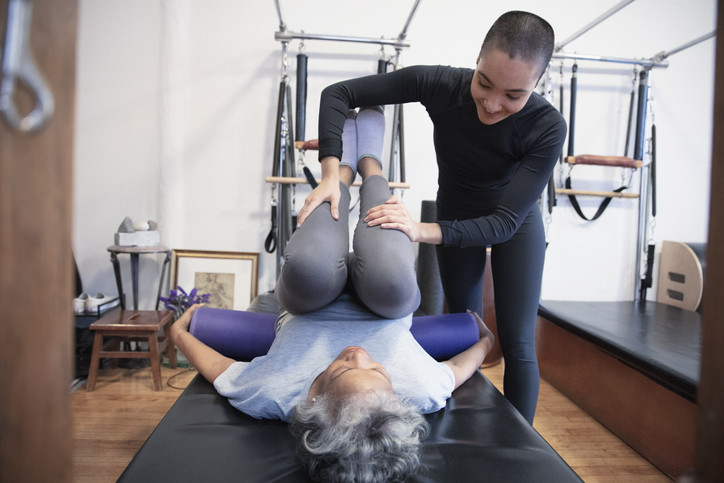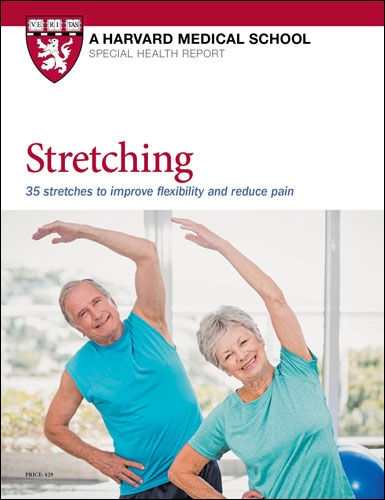Stretching studios: Do you need what they offer?

Boutique or specialty fitness studios offer all sorts of ways to exercise, such as strength training, indoor cycling, and kickboxing. Other popular options, like yoga and Pilates, are less likely to leave you sweaty and breathless, emphasizing flexibility and measured movement. Now a new trend has emerged: studios that focus solely on stretching. What are these studios offering, and will you benefit from this focus?
What are stretch studios offering?
These studios, which include StretchLab, StretchMed, LYMBYR, and others, provide assisted stretching sessions, either one-on-one or in small groups. The promised benefits range from reasonable goals of increasing flexibility and range of motion to more questionable assertions, such as preventing injuries and eliminating chronic pain.
"If you participate in certain sports that require flexibility, like dance or gymnastics, stretching may be important to maintain range of motion," says Dr. Adam Tenforde, associate professor of physical medicine and rehabilitation at Harvard Medical School, and sports medicine physician at Spaulding Rehabilitation and Mass General Brigham.
But if your focus is on improving your overall health, the evidence to support stretching is sorely lacking — especially compared with the wealth of evidence supporting the benefits of regular, moderate physical activity.
"Contrary to popular belief, there's no consistent evidence that stretching helps prevent injuries," says Dr. Tenforde. And if you have an existing injury, such as a muscle or joint sprain, aggressively stretching that tissue could actually make the injury worse, he adds.
The "stretch therapists" and "flexologists" at stretching studios may have certain certifications and training, but they're probably not qualified to recognize and address health-related causes for pain or stiffness. If you have a previous or current musculoskeletal injury, you're much better off going to a physical therapist who has the expertise and training to treat you correctly.
Feeling tight and stiff?
If you're free from injuries but just feel tight and stiff, try a yoga class, which can provide added benefits like improving your balance and helping you relax and de-stress. Or consider tai chi, a gentle, meditative form of exercise that can help lower blood pressure and enhance balance. Another option is to get a massage.
If you decide to try assisted stretching offered at a studio, listen to your body, and make sure you communicate how you're feeling with the therapist working on you, Dr. Tenforde advises.
But you'll probably do more for your overall health by spending that time taking a brisk walk or some other type of exercise instead, he says. Most Americans don't meet the federal recommended guidelines for physical activity, which call for 150 minutes per week of moderate-intensity exercise and muscle-strengthening activities twice weekly. "As doctors, we're dealing more with diseases related to inactivity, not diseases of inflexibility, says Dr. Tenforde.
Want to do your stretching at home?
Three easy morning exercises — an A-B-C routine of arm sweeps, back bend, and chair pose — can help ease morning stiffness. This also works well during the day if you spend too much time sitting.
Stretching at home could save you money and time. These tips can help you get the most out of at-home morning stretches or other flexibility routines.
- Warm up muscles first. Much like taffy, muscles stretch more easily when warm.
- Feel no pain. Stretch only to the point of mild tension, never to the point of pain.
- Pay attention to posture and good form. Posture counts whether you're sitting, standing, or moving. Photos of stretches tell only part of the story, so read instructions carefully to get form right.
- Focus on the muscle being stretched. One side of your body often is tighter than the other. Work on balancing this over time.
- Breathe. Breathe comfortably while stretching rather than holding your breath.
- Practice often. You'll make the best flexibility gains if you stretch frequently — daily, or on as many days of the week as possible. At the very least, try to do stretches two or three times a week.
About the Author

Julie Corliss, Executive Editor, Harvard Heart Letter
Disclaimer:
As a service to our readers, Harvard Health Publishing provides access to our library of archived content. Please note the date of last review or update on all articles.
No content on this site, regardless of date, should ever be used as a substitute for direct medical advice from your doctor or other qualified clinician.
















